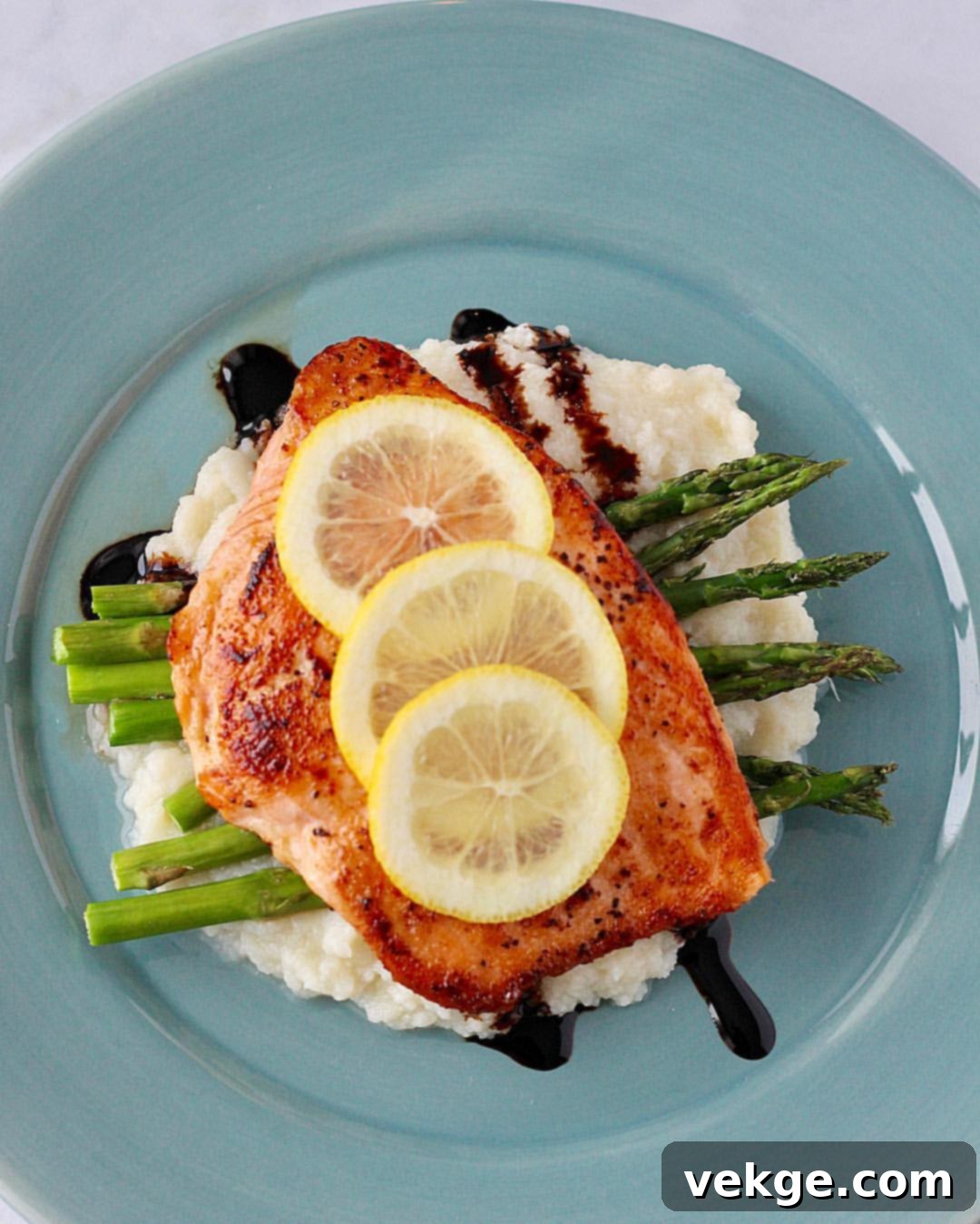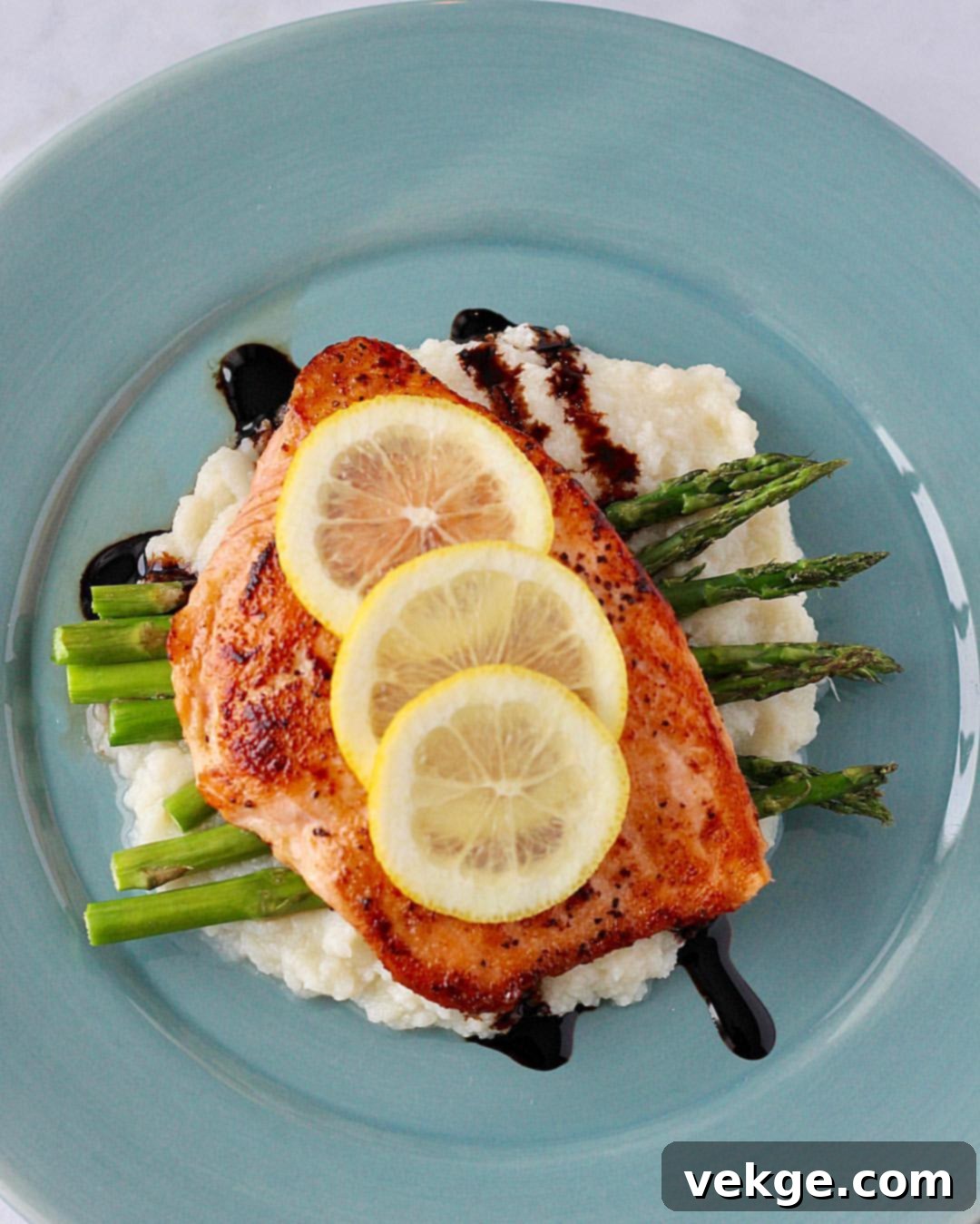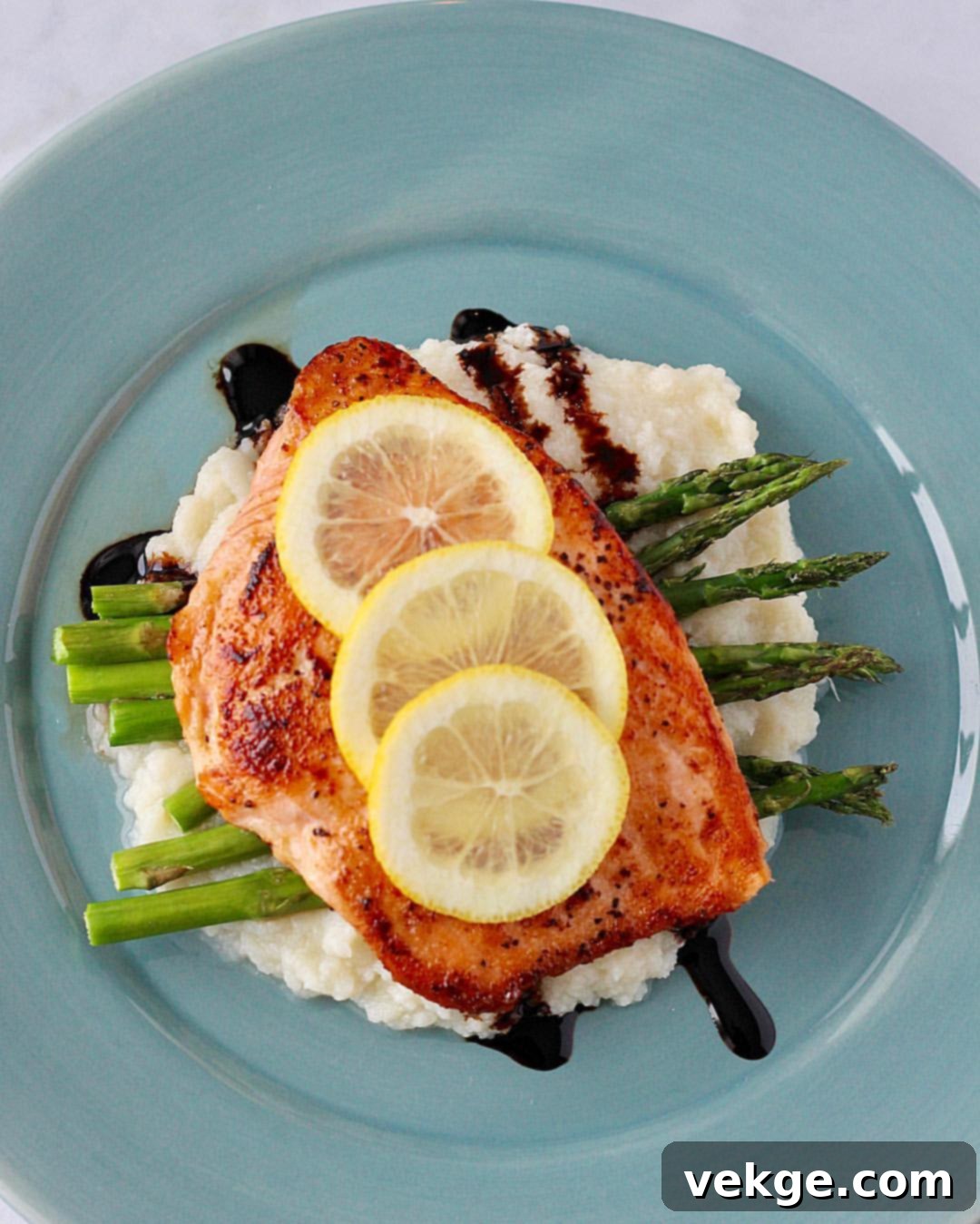Gourmet Weeknight Meal: Pan-Seared Wild Salmon with Creamy Cauliflower Mash and Roasted Asparagus
Discovering truly delightful and wholesome weeknight meals can feel like finding culinary gold. This particular dish, a harmonious blend of pan-seared wild salmon, velvety cauliflower mash, and perfectly roasted asparagus, crowned with an optional balsamic glaze, certainly fits the bill. It’s a meal that elevates your dinner experience from mundane to magnificent, yet remains remarkably simple to prepare.
My inspiration for this recipe sparked a few weeks ago during a memorable dinner with friends at a trendy protein-focused restaurant. My dear friend, @emilyjbaird, ordered a dish strikingly similar to this, and its vibrant presentation and enticing aroma immediately captured my attention. I knew instantly that I had to recreate that gourmet experience in my own kitchen. After a successful trial last night, I can confidently say it was an absolute triumph – so delicious that it has earned a coveted spot in my monthly meal rotation!
One minor note for families with younger palates: while adults typically adore the creamy cauliflower mash, the younger members of my household (those aged eight and under) weren’t entirely convinced. But don’t let that deter you! This is an easily adaptable recipe; for kids, you can effortlessly substitute the cauliflower mash with classic rice or mashed potatoes to ensure everyone at the table leaves happy and well-fed.

The Ultimate Healthy & Flavorful Dinner: Salmon, Cauliflower Mash & Asparagus
This recipe isn’t just a meal; it’s an experience. Each component brings its unique texture and flavor, contributing to a balanced and incredibly satisfying plate. The richness of the pan-seared wild salmon, the comforting creaminess of the cauliflower mash, and the crisp tenderness of the roasted asparagus create a symphony for your taste buds. It’s a dish that promises both culinary delight and nutritional benefits, making it an ideal choice for anyone looking to enjoy healthy eating without sacrificing flavor.
Beyond its incredible taste, what truly sets this recipe apart is its elegant simplicity. Despite its restaurant-quality appearance and complex flavors, the preparation is straightforward and manageable for a weeknight. With just 10 minutes of prep time and 35 minutes of cook time, you can have a magnificent dinner on the table in under an hour. It’s the perfect solution for busy individuals or families who desire nutritious, home-cooked meals without the fuss.

Cauliflower Mash, Roasted Asparagus, Balsamic Glaze, and Pan-Seared Wild Salmon
Had to share this delicious meal. It’s gorgeous, delicious, and quite simple!
Pin Recipe |
Rate This Recipe
- Course: Main Course
- Prep Time: 10 minutes
- Cook Time: 35 minutes
Ingredients
Cauliflower Mash
- 1 head cauliflower
- 1 Tablespoon butter
- 1/2 teaspoon salt
- 1/4 teaspoon garlic powder
- 1/4 teaspoon onion powder
- Optional additions: 1-2 Tablespoons cream cheese or sour cream for extra creaminess, fresh chives for garnish.
Roasted Asparagus
- 1 bunch fresh asparagus
- Cooking spray or 1 Tablespoon avocado oil
- Salt to taste
- Optional additions: lemon zest, black pepper, a sprinkle of grated Parmesan cheese after roasting.
Pan-Seared Wild Salmon
- 6-8 ounce wild salmon fillet
- Salt to taste
- Black pepper to taste
- Garlic powder to taste
- 1 Tablespoon avocado oil or cooking spray
- Fresh lemon for squeezing
- Optional additions: a pinch of smoked paprika or a dash of dill for enhanced flavor.
Balsamic Glaze (Optional)
- 1/2 cup balsamic vinegar (for homemade glaze) OR store-bought balsamic glaze
Instructions
Cauliflower Mash
- Rough chop the head of cauliflower into florets. Aim for similar-sized pieces for even cooking.
- Place the cauliflower florets into a steamer basket. Add 1 cup of water to the inner pot of your Instant Pot. Carefully lower the steamer basket into the Instant Pot.
- Secure the lid, twist the steam release valve to the “sealing” position, and select “Manual” or “Pressure Cook” on high pressure for 9 minutes.
- Once cooking is complete, allow for a natural pressure release (NPR) for 5-10 minutes, then carefully quick release any remaining pressure.
- Remove the cauliflower from the Instant Pot, drain any excess water thoroughly. Transfer the cooked cauliflower to a large bowl.
- Add the butter, salt, garlic powder, and onion powder to the cauliflower. Using a potato masher, fork, or immersion blender, mash until smooth and creamy. For an extra rich texture, consider adding 1-2 tablespoons of cream cheese or sour cream. This recipe typically yields about 3 servings of mash.
Roasted Asparagus
- Preheat your oven to 400°F (200°C).
- Prepare a baking sheet by spraying it lightly with cooking spray or lining it with parchment paper for easy cleanup.
- Wash the asparagus thoroughly. To trim, hold an asparagus spear at both ends and bend it gently; it will naturally snap where the woody end begins. Discard the tough ends, or simply trim the bottom 1-2 inches off each spear.
- Arrange the trimmed asparagus spears in a single layer on the prepared baking sheet. Lightly spray with cooking spray or drizzle with about 1 tablespoon of avocado oil, ensuring each spear is lightly coated. Season generously with salt (and optional black pepper or lemon zest).
- Roast in the preheated oven for approximately 10-12 minutes, or until the asparagus reaches your desired tenderness. It should be slightly crisp-tender and vibrant green.
Pan-Seared Wild Salmon
- Pat a 6-8 ounce wild salmon fillet dry with paper towels. This step is crucial for achieving a crispy skin. Season both sides generously with salt, black pepper, and garlic powder.
- Heat a non-stick or cast-iron skillet over a medium-high flame. Allow the pan to get nice and hot before adding the oil.
- Add 1 tablespoon of avocado oil to the hot skillet, or spray generously with cooking spray. Swirl to coat the bottom of the pan.
- Carefully place the salmon fillet skin-side down (if it has skin) into the hot pan. Cook for 3-5 minutes on the first side. Resist the urge to move or “scoot” the fillet until a beautiful golden-brown crust has formed. This helps prevent sticking and ensures a perfectly crisp exterior.
- Flip the salmon and cook for another 3-5 minutes on the second side, depending on the thickness of the fillet and your desired doneness. The fish should flake easily with a fork. For food safety, use a meat thermometer to check the internal temperature, which should reach at least 145°F (63°C).
- Once cooked, transfer the salmon to a plate. A fresh squeeze of lemon juice over the hot salmon immediately after cooking brightens its flavor even further.
Preparing Balsamic Glaze (Optional)
- If making homemade balsamic glaze, pour 1/2 cup of balsamic vinegar into a small saucepan.
- Bring to a simmer over medium heat and reduce, stirring occasionally, until the vinegar has thickened to a syrupy consistency, about 10-15 minutes. It should coat the back of a spoon. Be careful not to reduce too much, as it will continue to thicken as it cools.
- Alternatively, use a good quality store-bought balsamic glaze for convenience.
Assembling Your Plate
- To assemble this gourmet meal, start by placing a generous serving of the creamy cauliflower mash onto your plate.
- Next, artfully arrange the roasted asparagus spears alongside the mash.
- Gently place the perfectly pan-seared wild salmon fillet on top of or next to the mash.
- Drizzle with balsamic glaze if desired – it adds a lovely tangy sweetness and a beautiful visual appeal. While optional, it truly elevates the dish to another level.
- Finish the entire dish with a final squeeze of fresh lemon juice over the salmon and vegetables. Enjoy your delicious and healthy creation!
Why This Dish is a Weeknight Favorite
This Pan-Seared Wild Salmon with Creamy Cauliflower Mash and Roasted Asparagus isn’t just a recipe; it’s a lifestyle choice for health-conscious food lovers. It embodies everything you’d want in a dinner: it’s incredibly healthy, packed with lean protein and nutrient-rich vegetables. The wild salmon provides essential omega-3 fatty acids, while the cauliflower offers a low-carb alternative to traditional mashed potatoes, and asparagus contributes a wealth of vitamins and fiber.
Beyond its health credentials, the flavor profile is outstanding. The richness of the salmon, perfectly complemented by the subtle sweetness of the balsamic glaze, the earthy notes of the asparagus, and the comforting texture of the mash, creates a balanced and satisfying meal. Moreover, its relatively quick preparation time (under an hour from start to finish) makes it an absolute lifesaver for busy weeknights, allowing you to enjoy a gourmet experience without the extensive kitchen time.
Pro Tips for Culinary Success
- For the Cauliflower Mash: Don’t overcrowd your Instant Pot steamer basket. If you’re doubling the recipe, cook the cauliflower in batches or use a larger steamer. For an even creamier consistency, use an immersion blender directly in the pot, or transfer to a food processor after cooking.
- For Roasted Asparagus: Ensure the asparagus is dry before roasting to get optimal caramelization. For extra flavor, toss with a touch of garlic powder or red pepper flakes before roasting.
- For Pan-Seared Salmon: Always pat the salmon dry! Moisture is the enemy of a crispy crust. Ensure your skillet is hot enough before adding the oil and then the salmon. If your pan isn’t hot enough, the salmon might stick and won’t develop that beautiful golden sear. For perfect internal temperature, remove the salmon from the heat when it’s a few degrees shy of 145°F, as it will continue to cook a little (carryover cooking) while resting.
- Balsamic Glaze: If making your own, watch it carefully as it reduces. It can go from perfect to burnt very quickly. It should be thick enough to coat a spoon, but still pourable.
Variations & Substitutions for Every Palate
One of the beauties of this recipe is its versatility. Feel free to customize it based on your preferences or what you have on hand:
- Protein Swaps: Not a fan of salmon? This meal works wonderfully with other proteins like pan-seared chicken breast, grilled cod, or even pan-fried scallops. Adjust cooking times accordingly.
- Mash Alternatives: For a different flavor profile, consider sweet potato mash (roasted and then mashed) or parsnip mash. If cauliflower isn’t available, steamed broccoli florets mashed with butter and seasonings also make a delicious green alternative.
- Vegetable Sides: Instead of asparagus, try roasted green beans, Brussels sprouts, or a medley of bell peppers. You can roast them alongside the asparagus if they have similar cooking times.
- Flavor Boosters: Experiment with different herbs and spices. A sprinkle of fresh dill on the salmon, a dash of smoked paprika on the mash, or some fresh rosemary with the asparagus can introduce new dimensions of flavor.
- Kid-Friendly Options: As mentioned, plain rice or mashed potatoes are great for younger children. You can also lightly steam or roast other kid-approved vegetables like carrots or corn.
Storing Leftovers & Reheating Tips
This meal is fantastic fresh, but leftovers can also be a delightful next-day lunch or dinner. Store each component separately in airtight containers in the refrigerator for up to 2-3 days.
- Salmon: Reheat gently in a microwave on a lower power setting to prevent it from drying out, or briefly in a warm oven (around 275°F/135°C) until just heated through. Avoid high heat, which can make it rubbery.
- Cauliflower Mash: Reheats beautifully in the microwave or on the stovetop over low heat, adding a splash of milk or broth if it seems too thick.
- Asparagus: Best reheated quickly in a hot skillet or air fryer to regain some crispness, or simply enjoy at room temperature.
Frequently Asked Questions (FAQ)
- Can I use frozen cauliflower for the mash?
- Yes, you can! Frozen cauliflower florets work well for mash. You may need to adjust the cooking time slightly, often requiring a minute or two less in the Instant Pot or steamer, as they are usually pre-steamed.
- What’s the best way to tell if salmon is cooked through?
- The most reliable way is to use a meat thermometer. Insert it into the thickest part of the fillet; it should read 145°F (63°C). Visually, the salmon will change from translucent to opaque, and it should flake easily with a fork.
- Is balsamic glaze necessary for this dish?
- No, it’s entirely optional! The dish is delicious without it. However, the glaze adds a lovely sweet-tangy counterpoint that truly enhances the overall flavor profile and presentation.
- Can I bake the salmon instead of pan-searing?
- Absolutely! For baked salmon, preheat your oven to 400°F (200°C). Place the seasoned salmon on a baking sheet lined with parchment paper. Bake for 12-15 minutes, or until it reaches an internal temperature of 145°F (63°C). You won’t get the crispy skin, but it’s still very moist and flavorful.
Your Turn: Create This Delicious Meal Today!
This Pan-Seared Wild Salmon with Creamy Cauliflower Mash and Roasted Asparagus is more than just a recipe; it’s an invitation to elevate your everyday dining. Whether you’re a seasoned chef or a kitchen novice, the straightforward steps and incredible results will inspire confidence and delight. So, gather your ingredients, follow these simple instructions, and prepare to impress your family and friends (or just yourself!) with this healthy, gourmet-quality meal.
Don’t forget to share your culinary creations with us! We love seeing how you make these recipes your own. Enjoy every delicious bite!
